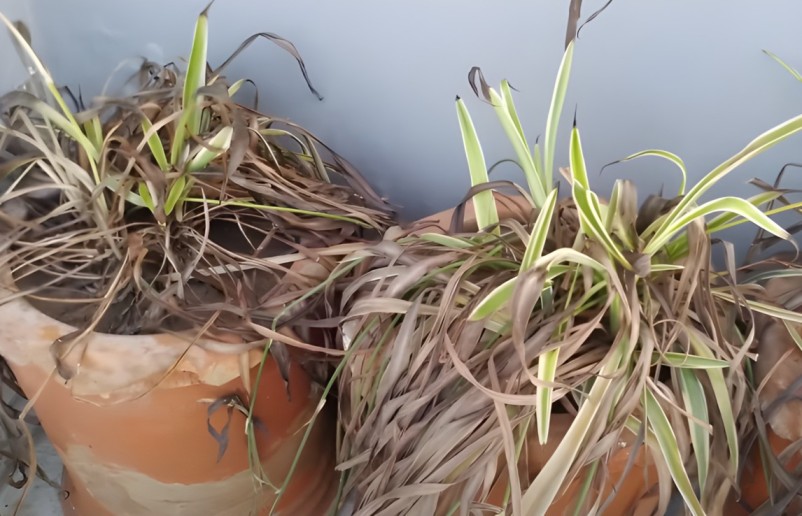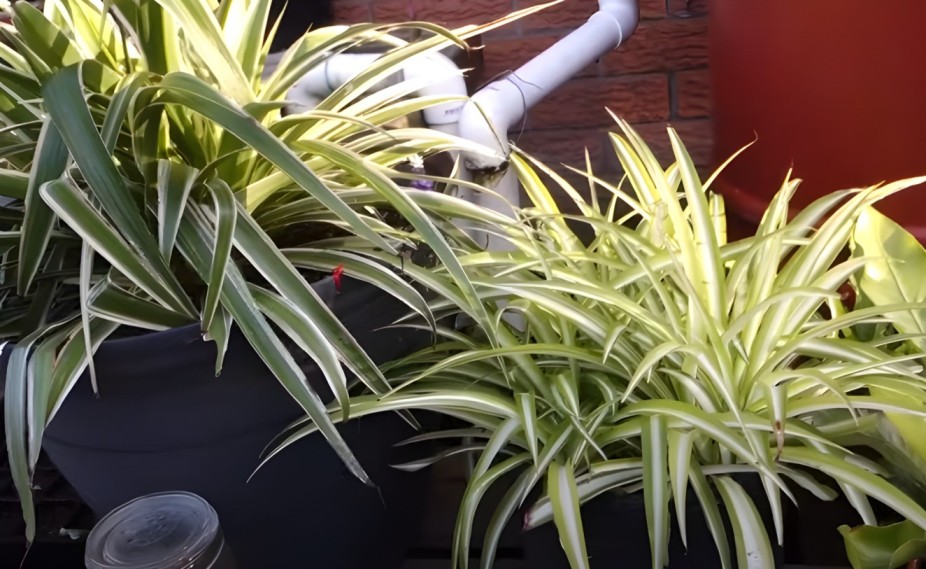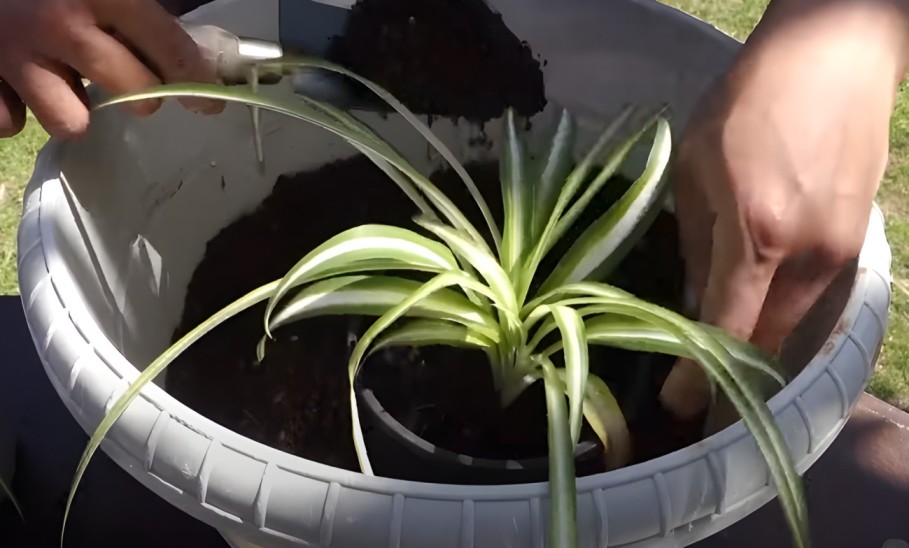Why Are My Spider Plant Leaves Bending – Leaflearns (2024)
The Spider Plant leaves Bending because of overwatering, inadequate light or due to lack of nutrients. Overcrowded roots or wrong pot size can also lead to bending. To solve the issue of bending, apply proper watering by letting the top inch of soil dry before watering Supply diffused full light and fertilize every two to four weeks during spring, summer, and fall.
Repot if the pot is too small and check for pests. Folding over damaged leaves may also promote vertical growth.

Contents
Causes of Spider Plant Leaf Bent
Underwatering
Underwatering is one possible cause of Spider Plant leaves bending. Spider Plants are sturdy, but inadequate water can cause the leaves to droop and bend. If the soil is too dry, the foliage hangs on for dear life, bending and wilting in clear sight.
How to Fix It
With a few critical steps, reviving your Spider Plant from underwatering is easy. To begin with, make sure that you water regularly but do not allow the soil to be saturated.
Ensure thorough watering, which should reach the roots. There are standard watering intervals, generally 1-2 weeks to adjust depending on other factors.
Overwatering
If your newly wilting Spider Plant leaves bending, it is most likely as a result of overwatering.
When you want to shower your green friend with love, remember that extra water may lead to root rot, weakening the plant and causing much drooping of leaves. The best soil for Spider Plants is well-draining as their roots are sensitive to soggy conditions.
How to Fix It
In order to save your Spider Plant, change the way you water it. Water only when the soil is dry; make sure there is good drainage.
If the soil has excessive moisture retention, consider repotting. It is advisable to trim off the yellow or soft roots and allow it to breathe.
Soil pH
If you have seen your Spider Plant leaves bending, then pH of soil is also responsible to a large extent. Spider Plants like slightly sour to neutral soils (pH 6-7). Nutrient inadequacy is caused by imbalanced pH levels, which causes leaf deformation and bending.
How to Fix It
To address this problem, begin by testing the soil pH using a kit that is sold in your local garden store. If it is very low (alkaline) or very high (acidic), consider soil amendment.
For high pH, use organic matter such as compost; for low pH, add lime. Check and adjust pH on a regular basis to maintain the range needed.
Pot-Bound
Your vibrant Spider Plant leaves bending is in trouble? One potential cause would be pot-bound conditions.
When the roots become too large for their pot, this prevents proper nutrient uptake and bending of the leaves results. Do not fear, however, because this problem has a solution.
How to Fix It
To save your Spider Plant, begin by delicately releasing it from its current pot. Look at the roots and cut off any twisted or crowded ones.
Transplant into a slightly larger pot containing adequate drainage making the roots grow freely. Make sure that your plant is provided with adequate water and light which makes it grow better.
Fertilizer
Your spider plant leaves bending due to problems with fertilization. If a plant is over-fertilized, there will be too much salt in the soil which is bad for them.
Bending or curling leaves is the result of this stress. Make sure to use a balanced diluted fertilizer and abide by the recommended rates of application.
How to Fix It
To rectify this, thoroughly flush the soil with water to wash out any excess salts. Change your fertilizing practices, using a more balanced liquid fertilizer and doing it less often.
To reduce water retention in your plant, make sure the soil is draining well. Keep a close eye on soil moisture and make necessary adjustments with regard to watering.
Insufficient Light
It is possible that low levels of light are the cause of your spider plant leaves bending. These vigorous green friends prefer bright indirect light and insufficient amounts cause leaf droopiness.
Inadequate light makes photosynthesis of the plant less efficient thus reducing growth as well as making its leaves lose their characteristic tautness.
How to Fix It
To correct this, move your spider plant to somewhere with bright indirect sunlight. Do not place the plants in direct sunlight, unless you want to burn their leaves.
Consider turning the plant from time to time, because each side should have equal light. If natural sunlight is inadequate, supplement with artificial light using a fluorescent bulb.

Incorrect Feeding
Spider plants are characterized by their resilience and bent leaves when they are provided with incorrect nutritional intake. Improper feeding, whether more or less, disturbs their fragile equilibrium.
Root burn results from over-fertilization because leaves fold or bend. On the other hand, inadequate nutrients affect normal growth which leads to weak, bending foliage.
How to Fix It
Assess Nutrient Levels: Apply a well-balanced liquid fertilizer that has other relevant elements such as nitrogen, phosphorus, and potassium.
Proper Watering: Keep the watering constant at a medium level to avoid nutrient imbalance and root problems.
Pest Infestation
Do you suddenly see your vibrant Spider Plant leaves bending. The covert assailant could be pest infestation.
Tiny seeds such as the spider mites or aphids can impair your plant, leading to those misliked bends. Early detection is critical as prevention is the golden cure.
How to Fix It
First, check the bottom of the leaves for any pests. Evicting unwanted guests is done by gentle cleaning with soap water or neem oil solution.
Quarantine affected plants to prevent the spread of the infestation, and maintain a regular watering pattern in order to enhance plant resistance.
The Wrong Container
Have you ever wondered why those vibrant leaves Spider Plant are sinking? One likely suspect could be their home in a container.
Spider Plants are best in cascading foliage preferred right space for vegetation. Rather, inadequate sized pots or ones with bad drainage can cause moisture problems, rood constrictions and finally those unwelcome bent leaves.
How to Fix It
Use a large pot with holes for drainage to revive the Spider Plant’s position. Select a container potting mix with good drainage, so the roots are adequately aerated.
You will need to repot your plant as it grows, ensuring that the roots have plenty of space. This small tweak, however, not only makes your Spider Plant look great but also helps improve its overall health.
Spider Plant Broken Leaves
If you find damaged leaves on your robust Spider Plant, don’t worry, bringing life to your green friend isn’t as difficult as it seems. Ensure that your Spider Plant is not only back to health but thriving with our expert tips.
To begin with, determine the problem could it be too much watering, not enough or light. Alter the frequency of watering and make sure your plant gets enough sunlight.
Cut away broken leaves with clean scissors, making the cut at an angle to produce a more visually appealing effect. Spiderettes encourage new growth and help improve the vigour of the plant.
On long-term care use a soil mix with good drainability and repot if required. Dusting the leaves at regular intervals will keep them shiny.
Root Rot
When the leaves of your Spider Plant start to bend, root rot may be the suspect. This fungus grows on the affected roots due to overwatering that causes too much water retention and reduces oxygen supply. Root rot damages the roots, preventing them from supporting the plant.
How to Fix It
To begin with, check the soil’s moisture; make sure it doesn’t hold water. Use sanitized scissors to trim off any mushy and discolored roots.
Replant the plant in clean, well-drained soil, trimming away the affected parts. Reduce your watering schedule a bit, allowing the soil to dry between applications.
Should Spider Plant Broken Leaves Be Pruned?
Absolutely! Considering both aesthetic and health-wise factors, pruning spider plant broken leaves is a good practice.
However, resilient plants usually recover from minor damage easily and removing broken leaves provides for better tidyness of the plant that will also direct the energy to new growth.
With clean scissors, make sharp removal cuts near the base of damaged leaves to provide an organized and splendid appearance. Apart from the beauty, pruning helps in warding off diseases and keeps the spider plant growing healthy top leaves.

Why are my spider plant leaves bending in half
Spider plant leaves may be bending into halves because of several reasons. A major source is insufficient light, these species prefer bright, indirect illumination and may bend if exposed to excessive or inadequate amounts of the same.
Leaf stress and curling can also be caused by overwatering or underwatering. Make sure that the soil drains well and let it dry out between watering. Further, environmental factors such as low humidity or high temperatures can also cause leaf curling.
Changing these conditions will help you to straighten the leaves of your spider plant and keep this condition from further worsening.
How do you spider plant leaves keep bending?
How to fix bent spider plant leaves
Watering
It is important to water spider plant leaves correctly in order to keep their health and integrity. Too much water will leave the soil soggy, which can result in root rot and weak leaves.
Water after the top inch of soil has dried out to maintain proper moisture levels for growth.
Sunlight
Spider plants grow well in indirect and bright light. Whilst they can take some shade, providing plenty of sun will ensure strong erect leaves.
Put your spider plant in a window with spotlight or diffused sun light, away from heat of the harsh afternoon sun so as to avoid leaf bending.
Fertilizer
It is important for spider plants to have a balanced fertilizer. During the growing season (spring and summer), apply a diluted all-purpose fertilizer once every 2 to 4 weeks.
This guarantees that they receive the appropriate nutrition needed to keep their leaves erect and maintain a vivid green color.
Pests
Watch out for pests, such as spider mites and aphids that make plants weaker thereby drooping off leaves. Check the bottoms of leaves daily and spray any infestations with organic insecticidal soap to keep leaf strength up to par.
Pot/Container Size
Each pot or container size is so important to choose. Choose a container that allows for drainage to prevent waterlog.
To ensure that the plant will have enough space for its roots to grow, choose a pot which is big enough for the current size of the plant. If the spider plant needs a bigger container, repot to support proper leaf growth.
Crucial Aspects of Spider Plant Care and Troubleshooting Leaf Issues
Spider plant care is essential for maintaining the health and vitality of these popular indoor plants. Whether you follow the advice of the renowned “Spider Plant Man” or consider the German approach with “spider plant pflege” and “spider plant vermehren,” understanding the basics of spider plant care and propagation is crucial.
However, challenges may arise, such as leaf issues where spider plant leaves bending, turning brown, curling, or changing colors like red, grey, pale, light green, or even transparent. Some specific issues, including leaves turning brown at the base or tips, can be addressed through proper care and attention, especially after repotting.

Bending and breaking of spider plant leaves, whether vertically or in half, pose additional concerns, raising questions like “why are my spider plant leaves bending?” or “should I cut bent spider plant leaves?” Yellowing issues, where leaves turn yellow and soft, brown, or crispy, prompt inquiries into the reasons behind this phenomenon.
Addressing specific questions about bending, color changes, and yellowing is crucial for ensuring the well-being of your spider plants.
FAQs
Why are the leaves on my plant bending?
Overwatering, lack of proper lighting, or nutrient deficiencies are typical causes of plant leaf bending. Evaluate these variables to resolve the problem and achieve healthier, more upright development.
Why is my spider plant leaves curling?
Curl of spider plant leaves may be caused by insufficient water, poor humidity and draught. Alter your watering schedule, increase humidity, give a stationary setting to avoid curling.
How do you stop a plant from bending?
In order to avoid the bending of plants, proper watering should be ensured, adequate sunlight should be provided; a well-balanced fertilizer should use and select an appropriate pot with good drainage. Frequently check for pests and respond quickly to any concern.
How can I improve my spider plant?
Your spider plant will do well when housed indoors under indirect, bright light, balanced watering practices, fertilizer application every 2-4 weeks during the growing season, and pest inspections. Repot, if necessary, and maintain proper humidity.
Is it normal for spider plant leaves to bend?
Bending spider plant leaves can be normal from time to time, but persistent bending might signify underlying problems. Assess components such as light, water, and nutrients to make sure that the plant is growing well.
Should I cut bent spider plant leaves?
In case the bending occurs as a result of pests, disease, or permanent damage cutting off affected leaves is recommended. Nevertheless, for trivial bending due to environmental influences, it is better to eliminate those influences than to consider cutting. Regular pruning also helps to keep the plant visually pleasant.






